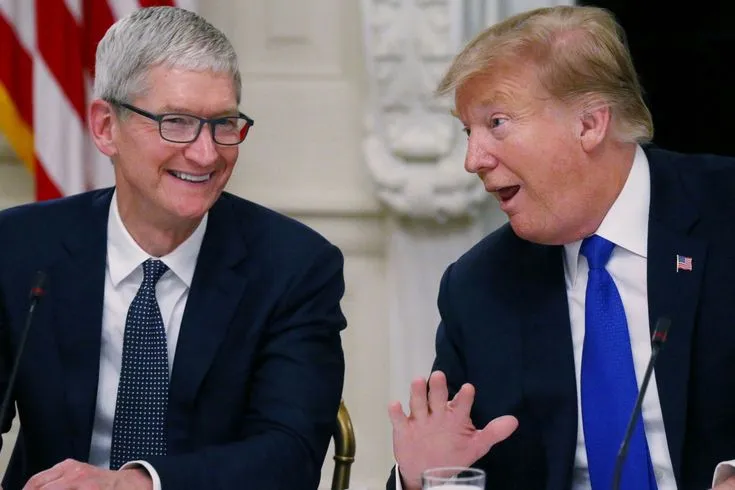25 Percents Tariff on Apple
Trump Threatens 25% Tariff on Apple – The tech world was shaken recently when Trump announced his intention to impose a devastating 25% tariff on Apple products, sending shockwaves through the industry and leaving consumers wondering about the future of their beloved smartphones. This bold move targets one of America’s most iconic tech companies and could fundamentally reshape the competitive landscape, potentially giving Samsung and other international manufacturers a significant advantage in the U.S. market.
The implications of this potential tariff extend far beyond Apple’s bottom line. From the average consumer contemplating their next smartphone purchase to major tech companies reevaluating their supply chains, Trump’s threat represents a seismic shift in trade policy that could redefine how Americans access and afford cutting-edge technology. Understanding the full scope of this development is crucial for anyone invested in the future of consumer electronics and global trade dynamics.
The Background Behind Trump’s Apple Tariff Threat
The relationship between political leaders and major tech companies has always been complex, but Trump’s latest move against Apple represents an unprecedented escalation in trade tensions. This threat didn’t emerge in a vacuum – it’s the culmination of years of mounting pressure on American tech giants to bring manufacturing back to domestic soil.
Apple’s heavy reliance on Chinese manufacturing has long been a point of contention for those advocating for American job creation and reduced dependency on foreign production. The company’s intricate supply chain, which spans multiple countries and involves hundreds of suppliers, has become a symbol of globalized manufacturing that some view as detrimental to American economic interests.
The timing of this tariff threat is particularly significant, coming at a moment when tech companies are already grappling with supply chain disruptions, inflation pressures, and increasing competition from international rivals like Samsung. For Apple, which has built its success on premium pricing and brand loyalty, a 25% tariff could force fundamental changes to their business model and pricing strategy.
Key Factors Driving the Tariff Decision
Several interconnected factors have contributed to this dramatic policy announcement:
- Manufacturing Dependency: Apple’s continued reliance on overseas production despite repeated calls for domestic manufacturing
- Trade Balance Concerns: The significant trade deficit with countries where Apple products are manufactured
- National Security Considerations: Growing concerns about technology dependence on foreign nations
- Economic Nationalism: Political pressure to prioritize American jobs and manufacturing capabilities
- Competitive Disadvantage: Perception that foreign companies receive unfair advantages through government subsidies
Immediate Impact on Apple’s Business Strategy
The threat of a 25% tariff forces Apple into an impossible position where every strategic decision carries massive financial implications. The company must now weigh the costs of potential price increases against the risk of losing market share to competitors like Samsung, who might not face similar tariff burdens depending on their manufacturing locations and supply chain structures.
Apple’s premium pricing strategy, which has been central to their brand identity and profit margins, becomes significantly more challenging when external tariffs are added to the equation. A 25% increase in costs could translate to smartphone prices that push even loyal customers toward more affordable alternatives, potentially accelerating the trend toward budget-friendly devices that has already been gaining momentum in recent years.
The company’s response options are limited and each carries substantial risks. Absorbing the tariff costs would devastate profit margins on products that already face increasing competition. Passing the costs to consumers could trigger a mass exodus to Samsung and other manufacturers who offer comparable features at lower price points. Alternatively, rushing to relocate manufacturing to avoid tariffs could result in quality control issues and supply chain disruptions that damage the company’s reputation for reliability.
Strategic Responses Apple Might Consider
Manufacturing Relocation Initiatives:
- Accelerated investment in domestic manufacturing facilities
- Partnership with American suppliers and component manufacturers
- Development of new supply chain relationships outside tariff-affected regions
- Investment in automated manufacturing technologies to offset higher labor costs
Pricing Strategy Adjustments:
- Introduction of more budget-friendly product lines to maintain market accessibility
- Restructuring of product portfolios to emphasize value propositions
- Implementation of flexible pricing models based on manufacturing location
- Enhanced trade-in programs to soften the impact of higher prices
Market Positioning Changes:
- Increased emphasis on American manufacturing as a premium feature
- Marketing campaigns highlighting domestic job creation and economic benefits
- Partnerships with American technology companies to strengthen supply chains
- Development of products specifically designed for American manufacturing capabilities
How Samsung and Competitors Stand to Benefit
The potential Apple tariff creates an unprecedented opportunity for Samsung and other smartphone manufacturers to gain substantial market share in the world’s most lucrative mobile device market. Samsung, in particular, is well-positioned to capitalize on any pricing disadvantages that Apple might face, given their diverse manufacturing footprint and established presence in multiple market segments.
Samsung’s strategic advantages become even more pronounced when considering their manufacturing flexibility and ability to adjust supply chains quickly in response to changing trade conditions. Unlike Apple’s concentrated reliance on specific regions and suppliers, Samsung maintains manufacturing facilities across multiple countries, providing them with options to optimize their supply chains for different market conditions and tariff structures.
The South Korean giant has already demonstrated their ability to compete effectively against Apple in premium segments while maintaining strong positions in mid-range and budget categories. A 25% tariff on Apple products could accelerate Samsung’s gains in the premium segment, where they’ve been steadily closing the gap in terms of features, design, and overall user experience.
Competitive Advantages for Samsung
Manufacturing Flexibility:
- Diverse global manufacturing footprint reducing tariff exposure
- Established relationships with suppliers across multiple regions
- Ability to quickly shift production based on trade conditions
- Investment in domestic manufacturing capabilities in key markets
Product Portfolio Breadth:
- Comprehensive range from budget to premium devices
- Ability to capture consumers across all price segments
- Established brand recognition in multiple market categories
- Innovation pipeline that competes directly with Apple’s offerings
Market Positioning Opportunities:
- Potential to offer comparable features at significantly lower prices
- Opportunity to emphasize value propositions over premium positioning
- Ability to target price-sensitive consumers who might abandon Apple
- Enhanced marketing opportunities highlighting cost advantages
The Broader Tech Industry Implications
The ripple effects of Trump’s tariff threat extend far beyond the Apple-Samsung rivalry, potentially reshaping the entire tech industry landscape in ways that could take years to fully understand. Tech companies across all segments are now forced to reconsider their manufacturing strategies, supply chain dependencies, and long-term planning assumptions.
Smaller tech companies and startups face particularly challenging decisions, as they often lack the resources to quickly pivot manufacturing locations or absorb significant cost increases. The barrier to entry for new tech companies could increase substantially if tariffs become a permanent fixture of the trade landscape, potentially reducing innovation and competition in the long term.
The threat also highlights the interconnected nature of the global tech ecosystem, where components, manufacturing, and assembly often span multiple countries and regulatory environments. A tariff on one company or product category can have cascading effects throughout the supply chain, affecting everything from component suppliers to retail partners to end consumers.
Looking for Premium Channels, Sports, and 4K Streaming?
Don’t miss out on these top-rated IPTV services – all at unbeatable prices!
🔥 TiviBridge – Ideal for sports lovers & international content
🎬 Iptvbridge – Perfect for live TV, movies & entertainment
💰 TiviPlanet – Best value for budget-conscious streamers
🚀 Start Your IPTV Business Today!
Get instant access to a powerful Reseller IPTV Panel with competitive pricing, advanced features, and 24/7 support. Join TiviBridge and grow your own IPTV empire with ease!
👉 Start your FREE trial now and elevate your viewing experience with seamless, high-quality streaming!
Industry-Wide Considerations
Supply Chain Restructuring:
- Accelerated trend toward supply chain diversification
- Increased investment in domestic manufacturing capabilities
- Development of new supplier relationships outside tariff-affected regions
- Enhanced focus on supply chain resilience and flexibility
Innovation Implications:
- Potential shift in R&D priorities toward cost-effective manufacturing
- Increased emphasis on modular design approaches
- Development of technologies specifically optimized for domestic production
- Collaboration opportunities between tech companies and domestic suppliers
Market Dynamics Changes:
- Potential for increased consolidation as smaller companies struggle with tariff impacts
- Enhanced importance of manufacturing location in competitive positioning
- Shift toward regional rather than global market strategies
- Increased government involvement in tech industry planning and development
Consumer Impact and Market Response
For everyday consumers, Trump’s tariff threat represents a potential watershed moment that could fundamentally alter their relationship with technology purchases and brand loyalty. The prospect of significantly higher prices for Apple products forces consumers to reconsider their purchasing decisions and potentially explore alternatives they might never have seriously considered before.
The consumer electronics market has always been driven by a complex interplay of features, pricing, and brand perception. A 25% tariff could disrupt this balance in ways that permanently alter consumer behavior patterns. Price-sensitive consumers might accelerate their migration to Samsung and other manufacturers, while Apple loyalists might delay purchases or seek refurbished alternatives.
The timing of this tariff threat coincides with a broader economic environment where consumers are already facing inflation pressures across multiple categories of goods and services. Adding significant costs to already expensive consumer electronics could trigger a broader reevaluation of technology spending priorities and purchasing patterns.
Consumer Decision Factors
Price Sensitivity Considerations:
- Impact on upgrade cycles and replacement timing
- Shift toward longer device lifespans and repair over replacement
- Increased interest in refurbished and pre-owned devices
- Enhanced focus on value-oriented purchasing decisions
Brand Loyalty Challenges:
- Testing of traditional Apple customer loyalty under price pressure
- Opportunity for Samsung to convert long-term Apple users
- Potential for emerging brands to gain market share
- Importance of feature parity in switching decisions
Market Behavior Changes:
- Acceleration of purchase decisions before tariff implementation
- Increased research and comparison shopping across brands
- Enhanced importance of total cost of ownership considerations
- Shift toward more pragmatic rather than aspirational purchasing decisions











